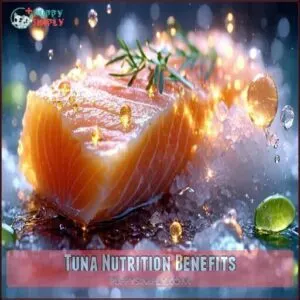This site is supported by our readers. We may earn a commission, at no cost to you, if you purchase through links.
 Yes, your dog can eat tuna fish occasionally, but it shouldn’t be a regular menu item.
Yes, your dog can eat tuna fish occasionally, but it shouldn’t be a regular menu item.
While tuna provides protein and omega-3 fatty acids, it contains higher mercury levels than other fish—something your furry friend’s smaller body can’t process as well as yours.
Stick to small portions (about a tablespoon for medium-sized dogs) and always choose tuna packed in water, not oil or brine.
Those puppy-dog eyes might beg for more, but moderation is key to avoiding digestive issues and long-term mercury buildup.
Many veterinarians recommend safer fish alternatives that offer similar benefits without the potential risks.
Table Of Contents
- Key Takeaways
- Tuna Fish Risks
- Can Dogs Eat Tuna
- Safe Fish Options
- Tuna Nutrition Benefits
- Feeding Tuna Safely
- Dog Health Considerations
- Tuna Allergy Signs
- Mercury Poisoning Risks
- Healthy Alternatives
- Safe Tuna Consumption
- Frequently Asked Questions (FAQs)
- Can dogs eat tuna?
- How to safely feed canned tuna to dogs?
- How long can a dog eat tuna?
- What happens if a dog eats tuna?
- How much canned tuna can I give my dog?
- Is tuna fish ok for dogs?
- Can dogs eat scrambled eggs?
- What canned fish can dogs eat?
- How do I prepare canned tuna for my dog?
- Can dogs eat canned tuna?
- Conclusion
Key Takeaways
- You can feed your dog tuna occasionally, but it shouldn’t be a regular part of their diet due to high mercury levels that can accumulate in their smaller body much faster than in humans.
- Always choose tuna packed in water (not oil or brine), rinse it to reduce sodium content, and limit portions to one teaspoon weekly for small dogs or one tablespoon for larger breeds.
- Watch for signs of mercury poisoning in your dog, including hair loss, anxiety, blindness, coordination problems, and kidney damage which can be fatal if left untreated.
- Consider safer fish alternatives like salmon, sardines, whitefish, or Arctic char that provide similar omega-3 benefits without the high mercury risks of tuna.
Tuna Fish Risks
You’re putting your furry friend at risk when you share tuna due to its dangerously high mercury levels that accumulate in a dog’s system much faster than in humans.
The high sodium content in canned varieties can also lead to dehydration, digestive upset, and potential kidney damage even in small amounts.
Mercury Poisoning Symptoms
Mercury poisoning in dogs can manifest through disturbing symptoms when they consume too much tuna.
Mercury poisoning in dogs strikes silently but manifests through disturbing symptoms—your furry friend deserves better than risky tuna.
Your furry friend may exhibit both physical and neurological signs as mercury accumulates in their system.
- Hair loss and anxiety are early warning signs of mercury toxicity
- Blindness and coordination problems indicate severe neurological damage
- Kidney damage can cause inability to urinate and abdominal swelling
Watch for these symptoms carefully, as mercury poisoning can be fatal if left untreated.
High Sodium Content
Beyond the mercury concerns, canned tuna’s high sodium content poses another significant risk to your dog.
Most commercial tuna contains excessive salt concentration that can lead to sodium toxicity in dogs.
This high salt content may cause dangerous water retention and hypernatremia (elevated blood sodium levels).
Even tuna packed in water often contains added salt.
Always check labels carefully when considering tuna for your furry friend, or better yet, seek safe alternatives with lower sodium levels to prevent sodium toxicity.
Digestive Issues
When your dog consumes tuna, it can wreak havoc on their digestive system, especially when fed canned varieties packed in oil.
The high fat content overwhelms their stomach, leading to serious digestive issues.
Here are four common tuna-related digestive problems:
- Severe stomach upset causing persistent vomiting
- Bloody diarrhea from intestinal irritation
- Pancreatitis triggered by excessive fat content
- Chronic indigestion resulting in reduced appetite
The listed problems can have a significant impact on your dog’s health, emphasizing the need for careful consideration of their diet to prevent digestive issues.
Allergic Reactions
While digestive issues can cause discomfort, allergic reactions to tuna in dogs can be far more serious.
Your furry friend might develop various symptoms if they’re allergic to this seafood.
| Symptom | What to Look For | Severity |
|---|---|---|
| Skin Irritation | Redness, itching, hives | Moderate |
| Vomiting Signs | Repeated heaving, lethargy | Serious |
| Breathing Issues | Wheezing, panting, coughing | Emergency |
Watch for these tuna allergy symptoms in dogs and seek veterinary advice immediately if breathing problems occur.
Can Dogs Eat Tuna
The question of whether dogs eat tuna requires careful consideration for every pet owner.
While technically dogs can consume tuna in very limited quantities, it’s generally not recommended as a regular part of their diet.
Tuna’s nutritional value doesn’t outweigh its significant risks.
Long-term effects of feeding tuna to dogs include potential mercury poisoning, particularly concerning for smaller breeds.
Breed size matters substantially when evaluating risks—smaller canines are more vulnerable to tuna’s dangers.
Raw tuna dangers are especially pronounced, as uncooked fish may contain harmful parasites.
If you’re wondering "is tuna safe?" for your furry friend, the answer is complicated: occasional tiny amounts might be tolerable for some dogs, but safer alternatives exist.
Tuna preparation methods can’t eliminate all risks.
The key consideration is the potential harm that tuna can cause to dogs, especially smaller breeds, due to its dangers.
It’s crucial for pet owners to prioritize their dog’s health and consider safer alternatives to tuna.
Safe Fish Options
You’ll find plenty of fish options that are both nutritious and safer for your furry friend than mercury-rich tuna.
Salmon, sardines, and whitefish provide excellent omega-3 fatty acids without the dangerous heavy metal content that makes tuna risky for regular canine consumption.
Smaller Wild Caught Fish
Smaller wild-caught fish are frequently a safer alternative to tuna for your canine companion.
These fish contain lower mercury levels while still providing excellent nutritional value.
When considering sustainable sourcing options for your dog:
- Choose sardines, which have minimal environmental impact
- Opt for Baltic sprat that can be served whole
- Remember that smaller fish accumulate less mercury due to biomagnification
These omega3-rich options are ideal regardless of your dog’s size.
Low Mercury Fish
When selecting Safe Seafood for your furry friend, prioritize Low-Mercury fish options.
Salmon, whitefish, herring, flounder, and Arctic char contain markedly lower mercury levels than tuna, making them safer choices for dogs.
These fish varieties still provide beneficial omega-3 fatty acids without the risks associated with higher mercury content.
For superior fish sourcing, choose smaller species that haven’t accumulated toxins through their shorter lifespans, and remember, proper cooking methods further guarantee your pet’s safety.
Nutritious Options
Looking beyond tuna opens up a world of nutritious options for your canine companion.
These fish provide excellent protein alternatives without the mercury risks:
- Salmon delivers powerful omega-3 benefits for coat health and reduced inflammation
- Sardines pack impressive mineral intake in a small package, supporting bone development
- Whitefish offers lean protein with balanced nutrition profile ideal for dogs with sensitive stomachs
These safe fish for dogs guarantee optimal health without compromising safety.
Many owners find that salmon is beneficial to their dog’s diet.
Tuna Nutrition Benefits
You’ll find valuable nutrients in tuna, including omega-3 fatty acids, high-quality protein, and essential vitamins that support your dog’s overall health.
While these nutritional benefits exist, they must be weighed against the significant mercury risks when deciding whether to include small amounts of tuna in your dog’s diet.
Omega 3 Fatty Acids
Tuna’s omega-3 powerhouse offers your dog significant health benefits despite mercury concerns.
These essential fatty acids support heart health, reduce inflammation, and promote a shinier coat.
While tuna contains valuable EPA and DHA fatty acid types, the mercury risk means you should consider safer omega-3 supplement sources.
Fish oil or specially formulated omega3 dogs supplements provide these nutrients without the dangers, following proper dosage guidelines for dietary inclusion.
Protein Content
While tuna offers impressive protein content for your dog, it’s essential to understand its nutritional value.
This lean protein packs a powerful punch with:
- Complete amino acids profile supporting muscle building
- Highly digestible protein that’s gentle on canine digestive systems
- Sustained energy source without excessive calories
- Natural protein that’s more bioavailable than many commercial alternatives
The protein benefits make tuna appealing, but always consider appropriate tuna serving size for your dog’s safety.
Vitamin Richness
Beyond the protein boost, tuna’s rich nutrient profile contains essential vitamins your dog’s body craves.
It’s packed with B vitamins that support energy metabolism and nervous system function. The nutritional value includes vitamins B6, B12, and niacin, which help maintain healthy skin and coat.
While tuna vitamins offer benefits, remember that tuna contains mercury that can be dangerous for dogs.
While tuna vitamins offer benefits, remember that proper omega-3 fatty acids and minerals can also be found in safer supplement alternatives.
Feeding Tuna Safely
If you’re determined to treat your dog with tuna, you’ll need to follow specific guidelines to minimize health risks.
Choose water-packed light tuna without added salt, and limit portions to just one teaspoon weekly for small dogs or one tablespoon for larger breeds.
Moderation Guidelines
While tuna offers nutritional benefits, feeding it to your dog requires careful moderation. Think of tuna as an occasional luxury, not a dietary staple. A safer option is to think about fish like salmon instead of tuna.
When considering tuna for dogs, follow these portion control guidelines:
- Extra-small dogs (2-15 lbs): maximum 1 teaspoon weekly
- Small dogs (16-25 lbs): 1-2 teaspoons weekly
- Medium dogs (26-60 lbs): 1 tablespoon weekly
- Large dogs (61+ lbs): 2-3 tablespoons weekly
Always seek veterinary advice before introducing tuna into your pet’s diet.
Choosing Right Tuna
If you’re considering feeding tuna to your furry friend, selecting the right type is essential.
For regular feeding, choose smaller fish lower on the food chain like herring, flounder, cod, or salmon instead.
Canned light tuna contains the lowest mercury levels, making it safer for dogs than yellowfin, white albacore, or especially bigeye tuna, and these alternatives offer similar nutritional benefits with fewer risks.
Preparing Tuna
Now that you’ve selected the right tuna, proper preparation is critical.
Always cook tuna thoroughly to eliminate harmful bacteria and parasites. Remove all bones painstakingly to prevent choking hazards.
When using canned tuna for dogs, rinse it under cold water to reduce salt content. Skip seasonings entirely—your pup doesn’t need them.
Serve in appropriate portions: a teaspoon for small dogs or a tablespoon for larger breeds. Plain, simple preparation keeps feeding dogs tuna as safe as possible.
Dog Health Considerations
Your dog’s overall health status directly affects how they’ll process tuna and its potential risks, particularly if they’ve existing conditions like pancreatitis or kidney issues.
You’ll need to take into account your pet’s complete medical history before introducing tuna, as even small amounts can trigger serious complications in vulnerable dogs.
Pancreatitis Risks
While tuna can be an occasional treat, your dog’s pancreas might strongly disagree.
The high fat content in tuna, especially when packed in oil, can trigger pancreatitis in susceptible dogs.
This painful inflammation occurs when digestive enzymes activate prematurely, basically causing the pancreas to digest itself.
Some breeds have higher predisposition to this condition.
- Tuna for dogs should be strictly limited if your pet has pancreatitis history
- Oil-packed varieties particularly increase inflammation risks
- Raw tuna introduces bacteria that may worsen gastrointestinal issues
- High-fat foods can trigger acute pancreatitis episodes requiring veterinary care
- Proper dietary management is vital for dogs with pancreatic sensitivity
Kidney Damage
Mercury in tuna targets your dog’s kidneys, potentially causing irreversible kidney damage.
When kidney function declines, you’ll notice reduced urine production and abdominal swelling.
These toxic effects demand immediate veterinary intervention, often requiring IV fluids or even dialysis in severe cases.
Watch for increased thirst, lethargy, or changes in urination patterns—all red flags for mercury poisoning.
Proper diet management means eliminating tuna risks for dogs, as kidney failure is often permanent and can be fatal if left untreated.
Balanced Diet Importance
While kidney damage is a serious concern, your dog’s overall dietary balance is equally important.
A well-planned canine diet includes proper nutrient ratios and appropriate caloric intake for your dog’s size and activity level.
Portion sizes matter—even healthy foods can disrupt balanced dog food routines when overfed.
Incorporate dietary variety to guarantee complete pet nutrition, and don’t forget hydration needs.
Tuna should only complement—never replace—quality dog nutrition.
Tuna Allergy Signs
You’ll need to watch for signs that your dog has a tuna allergy, which can include itching, hives, facial swelling, vomiting, or diarrhea shortly after consumption.
Even dogs without previous sensitivities can develop adverse reactions to tuna fish, making it essential to monitor your pet carefully after introducing this food, no matter how small the portion.
Symptoms of Allergy
While maintaining your dog’s health is essential, watch for tuna allergy symptoms that can appear quickly.
Your furry friend may show various signs if they’re allergic to this seafood.
Look for these warning signs:
- Skin reactions including itching, hives, or redness around the mouth
- Digestive upset manifesting as vomiting or diarrhea
- Respiratory issues like coughing or difficulty breathing
- Facial swelling, particularly around eyes and muzzle, which can be a sign of a severe reaction and may require immediate veterinary attention.
Sensitivity Reactions
Beyond the initial symptoms, your dog may develop sensitivity reactions that worsen over time.
These reactions often include skin irritations, redness, or hives that appear hours after tuna consumption.
Some breeds show predisposition to stronger immune responses against fish proteins.
Watch for digestive upset that persists longer than normal allergic reactions.
These adverse reactions can build up with repeated exposure, potentially causing long-term effects that require veterinary care.
Chronic itchiness can be one of the food allergies in dogs symptoms.
Treatment Options
If your dog shows signs of tuna-related issues, immediate veterinary care is essential.
Treatment typically includes supportive care with IV fluids for dehydration from dog vomiting or dog diarrhea.
For dog mercury toxicity, chelation therapy may be necessary to remove heavy metals.
Symptom management often involves anti-nausea medications, while severe cases might require kidney support or neurological rehab.
Early intervention dramatically improves your furry friend’s chances of recovery from dog poisoning symptoms, which can be helped by immediate veterinary care.
Mercury Poisoning Risks
You’ll need to watch out for mercury poisoning when feeding your dog tuna, as this industrial pollutant accumulates in tuna at levels substantially higher than in other fish.
Your dog’s smaller size makes them more vulnerable to mercury toxicity than humans, potentially causing serious symptoms like fur loss, blindness, and coordination problems.
Diagnosis Methods
In the face of potential mercury poisoning, your vet will conduct a thorough diagnosis using multiple methods.
Blood analysis and urine samples can confirm mercury exposure levels, while veterinary examination evaluates symptoms like vomiting, diarrhea, or other dog poisoning symptoms.
Tissue sampling (typically from kidneys) provides definitive mercury testing results.
Non-invasive options include fur analysis to screen for exposure.
Always seek immediate veterinary help if you notice dog stomach upset after tuna consumption.
Prevention Tips
While diagnosing mercury poisoning requires veterinary tests, prevention is always better than treatment.
You can protect your furry friend from tuna’s hidden dangers by taking simple precautions:
- Limit tuna to tiny portions once monthly, if at all
- Choose smaller tuna varieties with lower mercury content
- Consult your vet before introducing any fish to your dog’s diet
- Balance omega-3 needs with safer alternatives like salmon or specially formulated supplements to ensure a balanced diet and promote healthy living.
Healthy Alternatives
You’ll find several safe and nutritious alternatives to tuna that won’t expose your dog to dangerous mercury levels.
Salmon, sardines, and specially formulated omega-3 supplements provide the same health benefits without the risks, making them smarter choices for your furry friend’s diet, with health benefits.
Salmon and Sardines
Unlike tuna’s mercury dangers, salmon and sardines offer safer alternatives for your canine companion.
These fish-for-dogs champions provide abundant omega-3 fatty acids without the high mercury risks.
Wild-caught salmon benefits include quality protein and anti-inflammatory properties, while sardine nutrients pack a powerful nutritional punch in a tiny package.
When preparing these safe fish for dogs, remove all bones and cook thoroughly, and stick to appropriate serving sizes: about one tablespoon per 20 pounds of body weight weekly, to ensure a healthy and safe diet.
Other Low Mercury Fish
While salmon and sardines offer excellent nutrition, several other low-mercury fish deserve a spot in your dog’s treat rotation.
Safe seafood options like Arctic char, whitefish, flounder, and herring provide similar benefits without mercury concerns.
These fish alternatives deliver valuable protein and nutrients with minimal risk.
Whitefish advantages include mild flavor and easy digestibility, while herring benefits include exceptional omega-3 content.
When selecting fish for dogs, these low-mercury options create variety while maintaining safety and providing a valuable addition to their diet.
Omega 3 Supplements
Discover the perfect alternative to tuna with omega-3 supplements for your furry friend.
Veterinarians recommend fish oil supplements containing EPA and DHA to support joint health, skin, coat, and brain function.
Considering dog fish oil options can also be beneficial for your pet’s health, with products like Welactin Canine Softgels (the #1 vet-recommended brand) providing concentrated omega-3 fatty acids without mercury risks.
Dosage guidelines typically suggest one soft gel per 20 pounds of body weight, and always consult your vet before starting any supplement regimen.
Safe Tuna Consumption
If you’re determined to include tuna in your dog’s diet, you’ll need to follow specific guidelines to minimize health risks.
You should choose low-mercury options like light canned tuna (in water, not oil), serve only thoroughly cooked portions, and strictly limit quantities based on your dog’s size to ensure a safe and healthy experience for your pet, by following these strictly limit guidelines.
Low Mercury Options
While exploring healthy alternatives, you’ll want to know which tuna varieties contain less mercury if you occasionally treat your dog.
Light skipjack tuna typically contains lower mercury levels than albacore or yellowfin.
Some brands now offer "low-mercury" tested tuna products, but remember that even these safer options should be given sparingly—they’re still not as safe as salmon, sardines, or other fish like whitefish, or flounder for your canine companion’s omega-3 needs.
Cooking Methods
While low-mercury tuna varieties offer safer options, proper cooking methods remain critical for your dog’s safety.
Always thoroughly cook tuna to eliminate harmful bacteria and parasites.
When preparing tuna for your furry friend:
- Baking tuna steaks at 350°F until fully cooked is safest
- Grilling tuna without seasonings preserves flavor without adding harmful ingredients
- Boiling offers a simple method that removes excess fat
Many owners look for tasty tuna recipes for their pets.
Never serve fried fish to dogs as the oils can trigger digestive issues or pancreatitis.
Feeding Guidelines
When feeding tuna to your furry friend, follow these strict guidelines to guarantee safety. Serve tuna as an occasional treat only, limiting frequency to once a week maximum.
Always thoroughly cook fresh tuna or choose water-packed canned varieties without added salt. Remove all bones carefully before serving.
Mercury levels are a concern, so moderation is key. Due to tuna’s potential risks, vet consultation is essential, especially for dogs with existing health conditions, to ensure their overall well-being.
Portion Control
Now that you’ve learned about feeding guidelines, proper portion control is the next critical aspect of serving tuna to your dogs.
The right amount varies substantially by breed size:
- Extra-small dogs (2-15 lbs): 1 teaspoon weekly
- Small dogs (16-25 lbs): 1-2 teaspoons weekly
- Medium dogs (26-60 lbs): 1 tablespoon weekly
- Large dogs (61-90 lbs): 1-2 tablespoons weekly
- Extra-large dogs (91+ lbs): 2-3 tablespoons weekly.
Always monitor for dog tuna risks after serving.
Frequently Asked Questions (FAQs)
Can dogs eat tuna?
Dogs shouldn’t eat tuna regularly due to high mercury levels that can cause poisoning.
If you must feed tuna, limit it to tiny, occasional treats (once monthly) and choose water-packed varieties without added salt.
How to safely feed canned tuna to dogs?
It’s mind-blowingly important to drain water-packed, low-sodium canned tuna thoroughly.
You’ll want to serve only a teaspoon for small dogs or tablespoon for larger breeds, strictly limiting it to once weekly to prevent mercury accumulation.
This will help ensure the tuna is served safely, and the weekly limit is not exceeded.
How long can a dog eat tuna?
Limit your dog’s tuna consumption to once a month in small amounts – a teaspoon for small breeds or a tablespoon for larger dogs.
This helps prevent mercury buildup while allowing them an occasional treat.
What happens if a dog eats tuna?
Your furry friend might face health risks if they eat tuna.
Occasional small amounts are usually safe, but regular consumption can lead to mercury poisoning with symptoms like vomiting, hair loss, anxiety, and coordination problems.
They can exhibit symptoms like vomiting, hair loss, anxiety, and coordination problems when they have mercury poisoning.
How much canned tuna can I give my dog?
You should limit canned tuna to very small amounts: 1 teaspoon weekly for small dogs (under 25 lbs), 1 tablespoon for medium dogs (26-60 lbs), and 2-3 tablespoons for large dogs (over 60 lbs).
Is tuna fish ok for dogs?
Tuna troubles tend to outweigh benefits for dogs.
While not strictly toxic, tuna’s high mercury content poses risks.
You shouldn’t feed it regularly, but small, infrequent amounts of well-cooked, water-packed tuna are acceptable.
Can dogs eat scrambled eggs?
Yes, scrambled eggs are safe and nutritious for dogs.
They’re packed with protein and can be a healthy treat.
Just cook them plain without salt, butter, or seasonings that might upset your dog’s stomach.
What canned fish can dogs eat?
Dogs can safely eat canned salmon, sardines in water, and mackerel.
You’ll want to choose low-sodium options without added oils or spices.
These fish provide excellent omega-3 fatty acids without the mercury risks of tuna.
How do I prepare canned tuna for my dog?
Like traversing choppy waters, preparing canned tuna for your dog requires care.
Drain water-packed tuna thoroughly, rinse to remove excess sodium, and serve in appropriate portions based on your dog’s size.
Avoid oil-packed varieties.
Can dogs eat canned tuna?
While dogs can have small amounts of canned tuna occasionally, it’s not recommended for regular feeding due to mercury risks.
Choose water-packed varieties, avoid added salt, and limit servings to prevent potential health issues.
Conclusion
Ultimately, the question "can dogs eat tuna fish" requires a nuanced approach.
To protect your furry friend, serve tuna rarely and in tiny portions, choose water-packed varieties, and monitor for adverse reactions.
Better yet, switch to safer fish like salmon or sardines that provide similar benefits without the mercury risks.
Your dog’s health deserves thoughtful food choices—what seems like a harmless treat today could lead to serious health issues tomorrow.
Trust your vet’s guidance above all else, as it is crucial for making informed decisions about your dog’s diet and ensuring their overall health.
- https://www.fda.gov/Food/FoodborneIllnessContaminants/Metals/ucm115644.htm
- https://www.scientificamerican.com/article/how-does-mercury-get-into/
- https://www.consumerreports.org/cro/magazine/2014/10/can-eating-the-wrong-fish-put-you-at-higher-risk-for-mercury-exposure/index.htm
- https://www.unr.edu/nevada-today/news/2021/mercury-in-pet-food



















